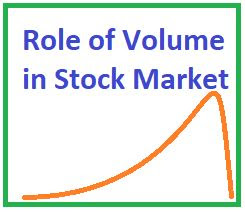NSE LIVE ROLES OF VOLUME
WHAT IS VOLUME?
Volume is simply the number of shares (or contracts) traded during a specified time frame (e.g., hour, day, week, month, etc). The analysis of volume is a basic yet very important element of technical analysis. Volume provides clues as to the intensity of a given price move.
Why Volume is Important?
Volume is used by technical analysts to confirm trends and chart patterns. The strength of any given price movement is measured primarily by the volume. In fact, a 50% rise in a stock price may not be all that relevant at all if it occurs on very little volume – just look at penny stocks.
For example, suppose that a stock jumps 5% in one trading day after being in a long-term downtrend. Is this a reversal of the long-term trend? The answer depends on whether there was a substantial amount of volume behind the move. If the volume was below average, the move was likely a fluke and the downtrend is likely to continue. On the other hand, if the volume was significantly higher than average, then it could be the start of a reversal.
INTERPRETATION
There are many ways to interpret changes in volume trends. One common belief is that rising prices coupled with increased volume, and falling prices coupled with decreased volume, is bullish. Conversely, if volume increases when prices fall,and volume decreases when prices rise,the market is showing signs of underlying weakness. —The theory behind this is straight forward. Rising prices coupled with increased volume signifies increased upside participation (more buyers) that should lead to a continued move. Conversely, falling prices coupled with increased volume (more sellers) signifies decreased upside participation
- PRICE UP+HEAVY VOLUME= UPTREND IS SUSTAINABLE
- PRICE UP+LIGHT VOLUME= UPTREND COULD BE TEMPORARY
- PRICE DOWN+HEAVY VOLUME= DOWNTREND IS SUSTAINABLE
- PRICE DOWN+LIGHT VOLUME= DOWNTREND COULD BE TEMPORARY
Usually in an up-trending market volumes are heavy during up-moves and light during down-moves. So a trader uses volume analysis for better entries. HOW? Say ABC share is in an uptrend, everything seems strong. Suddenly it gets corrected a bit. Now that a strong stock is available at a better(lower) price to buy, people fear it could tank more and miss out opportunities to enter, only to find out that it starts to move up again. In such cases smart investors and traders look at volumes. If they can clearly see that 'this correction' was not supported by significant volumes, they start buying into the market at better price than others.
OTHER USES
Volumes not only give clues about strength of trend but also about validity of breakouts and breakdowns. A resistance zone breached(breakout) with heavy volumes is regarded as a genuine breakout. Whereas a resistance breakout accompanied by light volumes usually results into false breakouts. The case is same for support breakdown or a up or down trend-line breach.
- RESISTANCE BREAKOUT+HEAVY VOLUMES= GENUINE BREAKOUT
- RESISTANCE BREAKOUT+LIGHT VOLUMES= FALSE BREAKOUT
- SUPPORT BREAKDOWN+HEAVY VOLUME= GENUINE BREAKDOWN
- SUPPORT BREAKDOWN+LIGHT VOLUME= FALSE BREAKDOWN
- UPTREND LINE BREACHED ON THE DOWNSIDE+HEAVY VOLUME= HIGH CHANCE OF REVERSAL
- UPTREND LINE BREACHED ON THE DOWNSIDE+LIGHT VOLUMES= LOW CHANCE OF REVERSAL
- DOWNTREND LINE BREACHED ON THE UPSIDE+HEAVY VOLUME= HIGH CHANCE OF REVERSAL
- DOWNTREND LINE BREACHED ON THE UPSIDE+LIGHT VOLUME= LOW CHANCE OF REVERSAL
trading volume analysis
Source-Telegram




No comments